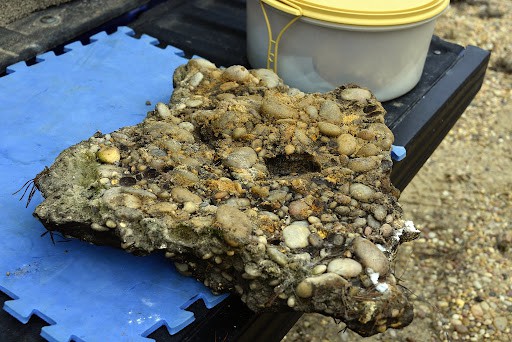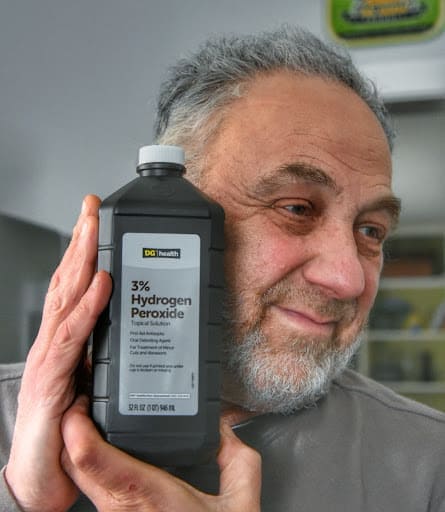Hydrogen peroxide is a good cleaning solution for rocks. It is important that you do not use a highly concentrated form of it as this could damage them. Allow the rocks to sit for two to three days in the solution before removing them, rinsing them and leaving them to dry.
There are as many different ways to clean rocks as people who collect them or use them in aquariums. Different methods of cleaning are required for different types of rocks.
If you’ve tried one method and it did not work, many other ones to experiment with.
You can use oxalic acid. Others may choose solutions made with baking soda. Still, others use vinegar or hydrochloric acid.
In this post, we will look at cleaning rocks with hydrogen peroxide.
What Peroxide Does To Rocks

The effect of cleaning rocks with peroxide will depend on the concentration of the hydrogen peroxide solution and the type of rocks you are cleaning. It can be used to remove plant materials such as moss or lichen from the stones.
You can also use peroxide to remove stains, and still, others use it to loosen organic material such as minerals and clay. Hydrogen peroxide does this in a couple of ways.
1. Mechanical Reaction
The bubbles from peroxide can clean dust, clay, and other debris from cracks and crevices in the rocks, usually better than plain soap and water.
2. Chemical Reaction
Organic stains are usually dissolved pretty easily by hydrogen peroxide. As the peroxide is broken down into water and oxygen, it can clean away stains.
Types Of Stains Hydrogen Peroxide Can Clean
There are a couple of stains that hydrogen peroxide can clean effectively. Rocks and stones that have these types of stains deep in crevices can be cleaned easily with this solution.
- Hydrogen peroxide is a good choice for cleaning rocks that have manganese staining. This is a common stain on stones found in desert areas. You’ll recognize it by the orange and black patina on the surface.
- Peroxide can also work on iron stains. Unless the stains are very deep in the rock, this solution can easily remove them.
- Agate stones usually do well with peroxide cleaning, as their bubbles can reach into the pockets found on the surface.
- It may not be as beneficial for cleaning stones such as quartz and amethyst. These rocks may require chemicals that are a bit harsher.
- Hydrogen peroxide works well on black algae found on aquarium rocks. It can also remove flagellates and fungal infections and is under FDA testing to discover its validity as an anti-parasitic that will eliminate ectoparasites.
Testing How Well Hydrogen Peroxide Will Clean Your Rocks
Of course, the best way to know whether or not peroxide will clean the debris and stains from your rocks is by trying it out. It’s pretty simple to do this. First, you will need to prepare the rocks.
What You Will Need:
- Rocks or stones
- Running water
- Toothbrush
- Towel for drying the rocks
Instructions:
- Gather rocks from outside, or get some that you’ve collected before that might need cleaning.
- Rinse them under running water.
- Using a toothbrush, loosen dirt and debris from their surface.
- Rinse under running water again
- Dry the stones, or allow them to air dry.
Once you have followed the steps to prep the rocks, it is time to test the hydrogen peroxide to see how well it cleans the stones.
Materials:
- Mason jar
- Grocery store-purchased hydrogen peroxide.
- Running water
- Toothbrush
- Towel for drying
What To Do Next:
- Place the rocks in a clear jar such as a Mason jar.
- Pour the type of hydrogen peroxide that you’d purchase from the grocery store over the rocks.
- Although the peroxide will foam, you should fill the jar until the rocks are submerged.
- Watch for any alarming signs of a chemical reaction. It should not be smoking, etc.
- Allow the stones to sit for two or three days in the solution.
- Remove the rocks from the jar.
- Rinse the rocks under running water.
- Scrub any remaining spots with the toothbrush.
- Allow the rocks to dry.
Once this process has been completed, you will be able to see if there is any difference in the appearance of the rocks.
If there is, you know that hydrogen peroxide will work on the types of rocks that you have.
Other Products To Try
If this does not clean your rocks, there are other products that you can try. These are not recommended for fish aquarium rocks.
- Soda such as Coca Cola or Pepsi
- Bleach
- Vinegar
- Lime Away
- Toilet Cleaner
- Beekeeper’s Friend
- Windex
- Iron Out
- Hydrochloric Acid
Why Use Hydrogen Peroxide To Clean Aquarium Rocks?

Hydrogen peroxide is good for cleaning the stones of rock collectors and can be a beneficial cleaner for your fish aquarium rocks. In fact, not only does it clean product stains and dirt well from the rocks, but it also has several other benefits for your fish tank.
- It works well as an antifungal and anti-algae in your fish tank, which can extend the life of your fish.
- Hydrogen peroxide also has antibacterial properties and can kill bacteria such as Aeromonas, which can cause symptoms from discoloration to internal bleeding in fish.
- It works well as a disinfectant, which can help prevent fin rot disease, vibriosis, and swim bladder disease.
- Peroxide can also kill the bacteria that cause the aquarium to foul odor.
Knowing all of this, it is easy to see why hydrogen peroxide would be considered a safe substance to clean the rocks that go into your fish aquarium.
How To Clean Your Fish Aquarium Rocks With Hydrogen Peroxide
Cleaning the rocks and the faux plants and other decorations inside of a fish aquarium is considered safe as long as you are using the common 3% solution.
Materials:
- Common, store-bought hydrogen peroxide
- Large bowl
- Kitchen colander
- Running water
- Towel
Instructions:
- Empty the aquarium rocks into the large bowl.
- Pour the 3% hydrogen peroxide solution over the rocks until submerged.
- Allow the rocks to sit for at least an hour.
- Pour rocks into the kitchen colander and rinse them under running water, using your hand to stir the rocks around, removing residue.
- Spread the rocks out on a towel to dry. You might choose to allow them to dry outside in the sunshine fully.
Safety Precautions
If you are using the appropriate peroxide version, there is no need to wear safety gloves or goggles as they will not harm your skin. If you are experienced in peroxide and using a higher concentration, safety measures should be taken.
FAQs on Cleaning Rocks With Hydrogen Peroxide
Can Hydrogen Peroxide Get Old Or Expire?
Like food, medications, and many other chemicals, hydrogen peroxide has a shelf life. Once the bottle has been opened, it can lose its effectiveness over time. If peroxide doesn’t bubble when dropped into the sink, it’s probably too old to clean.
How Do I Dispose Of Used Hydrogen Peroxide?
It is easy to dispose of hydrogen peroxide. If you are using the 3% solution as you would buy at a local grocery store, then it can safely be poured down the drain when you are finished.
Can I Add Other Chemicals To The Peroxide To Help It Clean The Rock More Thoroughly?
Unless you are trained in mixing chemicals and understand exactly what will happen, it is not advised to mix anything with peroxide on an experimental basis. Harmful gasses or poisons can be formed when this happens.